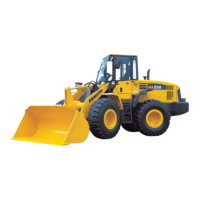.
PRECAUTIONS FOR LOW TEMPERATURE
If the temperature becomes low, it becomes difficult to start the engine, and the coolant may freeze, so do as follows.
Change to fuel and oil with low viscosity for all components. For details of the specified visicosity, see "USE OF
FUEL, COOLANT AND LUBRICANTS ACCORDING TO AMBIENT TEMPERATURE (PAGE 4-8)".
For details of the antifreeze mixture when changing the coolant, see "CLEAN INSIDE OF COOLING SYSTEM
(PAGE 4-20)".
Use a Permanent Antifreeze (ethylene glycol mixed with corrosion inhibitor, antifoam agent, etc.) meeting the
standard requirements as shown below. With permanent antifreeze, no change of coolant is required for a year. If
it is doubtful that an available antifreeze meets the standard requirements, ask the supplier of that antifreeze for
information.
Standard requirements for permanent antifreeze
SAE J1034
FEDERAL STANDARD O-A-548D
In areas where permanent antifreeze is not available, it is possible to use antifreeze whose main component is
ethylene glycol and does not contain any corrosion inhibitor. (Such antifreeze can be used for the winter season
only.) However, in such a case, the cooling water must be changed twice a year (spring and fall), so use permanent
antifreeze when possible.

